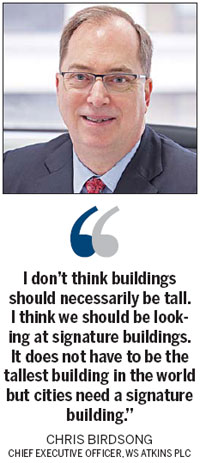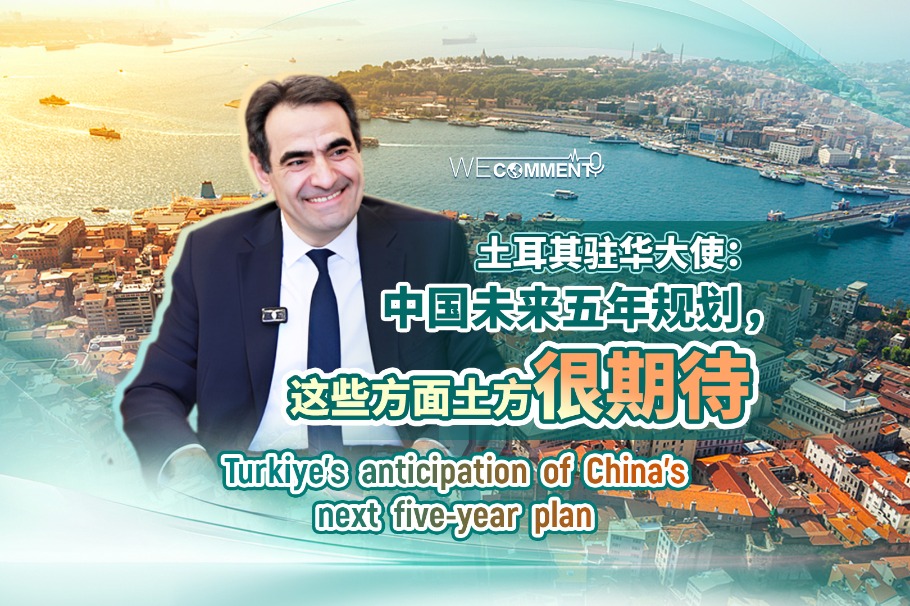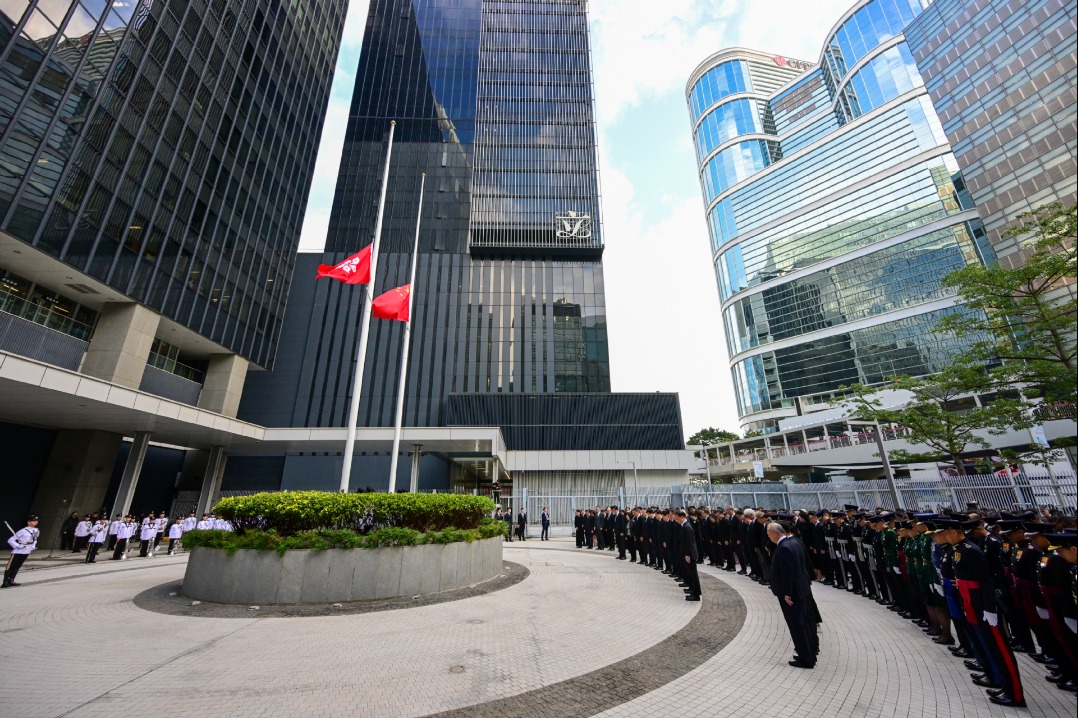Building the future in a sustainable way

Architect firm's boss outlines blueprint for next generation of metropolitan life
Walking into the Beijing office of WS Atkins Plc, a design, engineering and project management consultancy firm based in the United Kingdom, it is hard to ignore the models of many world renowned buildings on display - from the Burj Al Arab in the United Arab Emirates to the Olympic Park for the London 2012 Games. All of them are projects by Atkins.
Atkins' Asia-Pacific Chief Executive Officer Chris Birdsong, sitting near the windows facing Beijing's Chang'an Avenue and the visible traffic volumes on the road, is equally proud of the company's works in the rapid urbanization of China.
Pointing at a framed picture on the wall, he says the 2012 project features part of the neighboring Tonghui River in the central business district being regenerated.
"Urban regeneration is a natural part of the development of cities," says Birdsong. "We would call some of that 'brownfield development'."
He refers to self-regeneration of the city as a part of its natural life cycle.
"So when you take Shanghai, Beijing or London as examples, you expect regeneration. Many times you have cities that have areas suffering from blight and areas that don't regenerate because of social issues or economic issues, or that weren't in the right position for the city.
"And when they don't regenerate, city governments are forced to intervene to do the job."
Regeneration in China is just in its infancy, says the CEO, who joined the firm in 2007.
Previously, he worked for Bechtel Corp, a construction and project management firm, for more than 33 years, involved with notable projects including the UK's West Coast rail network modernization program.
For the last 30 years, there has been massive development in China because of its population growth. Over the next 20 years, there will be another 300-plus million people moving to cities in China, a number the size of the population of the United States, he says.
But lots of that urbanization over the next 20 years would be a combination of brownfield and greenfield, otherwise known as undeveloped sites.
Greenfield development means one can build a new city. He says the future landscape in China will mainly involve redevelopment within cities such as Shanghai, Shenzhen, Chengdu and Chongqing, as well as the regeneration of second and third-tier cities, plus new city development.
Regenerating cities from within is more complex than starting afresh, says Birdsong.
"It's not about building something new. It's about taking something that exists and altering it. It is more complex, more time-consuming, with more people to consult, more stakeholders, more complex problems, particularly with local governments," he says.
He cited the example of his office building, which used to be warehouses. The surroundings were all warehouses a decade ago but then gradually developed into part of the CBD.
The firm has many regeneration projects in Beijing including the Tanzhe Temple that is a heritage and tourism site, as well as industrial zones in the Yizhuang district.

Both examples involve designing solutions calling on many different views from land developers, local governments and consultants such as Atkins, which claims its strength from its global experience and local know-how in the field.
The firm regenerated east London for the Olympics. Birdsong says it was not just the Games. As a sustainable development, it was actually the largest and newest park built in London in 200 years, which has an economic base to it and has transport links, with different levels of living conditions depending on income.
"We bring those skills not only from London, but from European cities, US cities, Middle East cities," he says.
"We bring this international know-how but couple it with local know-how."
About 90 percent of Atkins' staff are local.
"To work effectively in urban regeneration and build future-proofed cities, you have to understand the local conditions, how they function, how you relate to the local authorities and how you develop your personnel," he says.
Knowing how to work locally and within the local processes to actually get the best idea involves getting the best position, the best ideas with the best long-term economic forms to be successful, he adds.
"When we talk about tourism, we hired a local university professor for that. We have to have local people in addition to ourselves. When they have a heritage issue, for example, we have a very capable lady in the UK who understands heritage very well. She actually came here to China to work with the Chinese government on the heritage of Chinese pottery because she also has expertise in pottery. That is the beauty of being local but international," he says.
The challenge is making a development fit into the culture. It is to fit those ideas together and come up with the best solution, both from an economic standpoint and from a positioning standpoint, he adds.
Over the past three decades, China has grown quickly but the speed has been slowing down.
"You are seeing governments and cities think more about the future. We call that future-proofing cities," he says.
Many local governments in China are realizing that they have to think about tomorrow. Birdsong says now he thinks it is about how they will have livable cities, the places where people want to be. It is a natural part of the process that one goes through, he says.
Future-proofing a city is not just about eliminating gridlock. It is about having a sustainable city that focuses on transport, infrastructure, environment, energy and climate, the CEO says.
Nowadays in China, a project has to sustain itself. Take the Chongqing Metro as an example, says Birdsong. There is no more money to come from the government to finish it.
"Therefore one has to look at how to maintain and how to run the system.
"It is now important to know how to develop projects that have the right returns, that will be self-sufficient over time," says Birdsong.
A five-minute drive away from Birdsong's Beijing office stands the CCTV building, the latest city landmark, among the mushrooming of skyscrapers that now define the skyline of Chinese cities.
Birdsong does not think the pursuit of height is the answer to the future landscape of cities in the country.
"I don't think buildings should necessarily be tall. I think we should be looking at signature buildings. It does not have to be the tallest building in the world but cities need a signature building."
In San Francisco they have the Transamerica Pyramid Building. In London they have the Shard.
"You go to Chengdu and you see all those areas that have been redeveloped, such as the old tea-houses," he says.
Massive urbanization means massive opportunities for design, engineering and project management consultancy for Atkins.
"The Chinese mainland business accounts for at least 45 to 50 percent of our work in the Asia-Pacific region, one of the most significant urban master planning businesses we have," he says.
The main businesses on the Chinese mainland are urban planning, architecture and sustainability in terms of smart buildings, plus sustainable buildings. Revenue in the last fiscal year that ended March 31, 2013, was 1.7 billion pounds ($2.74 billion).
Birdsong, who traveled to China for projects in the 1970s, moved to Hong Kong after his appointment.
"You have to be part of it. Just coming as a visitor does not really work. You need to be the part of the fabric. It is quite exciting," he says.
wangzhuoqiong@chinadaily.com.cn
| An artist's impression of Tonghui river in Beijing's central business district. Its regeneration is a project being carried out by WS Atkins. Provided to China Daily |
(China Daily European Weekly 12/06/2013 page21)
Today's Top News
- Chinese landmark trade corridor handles over 5m TEUs
- China holds first national civil service exam since raising eligibility age cap
- Xi's article on CPC self-reform to be published
- Xi stresses improving long-term mechanisms for cyberspace governance
- Experts share ideas on advancing human rights
- Japan PM's remarks on Taiwan send severely wrong signal































